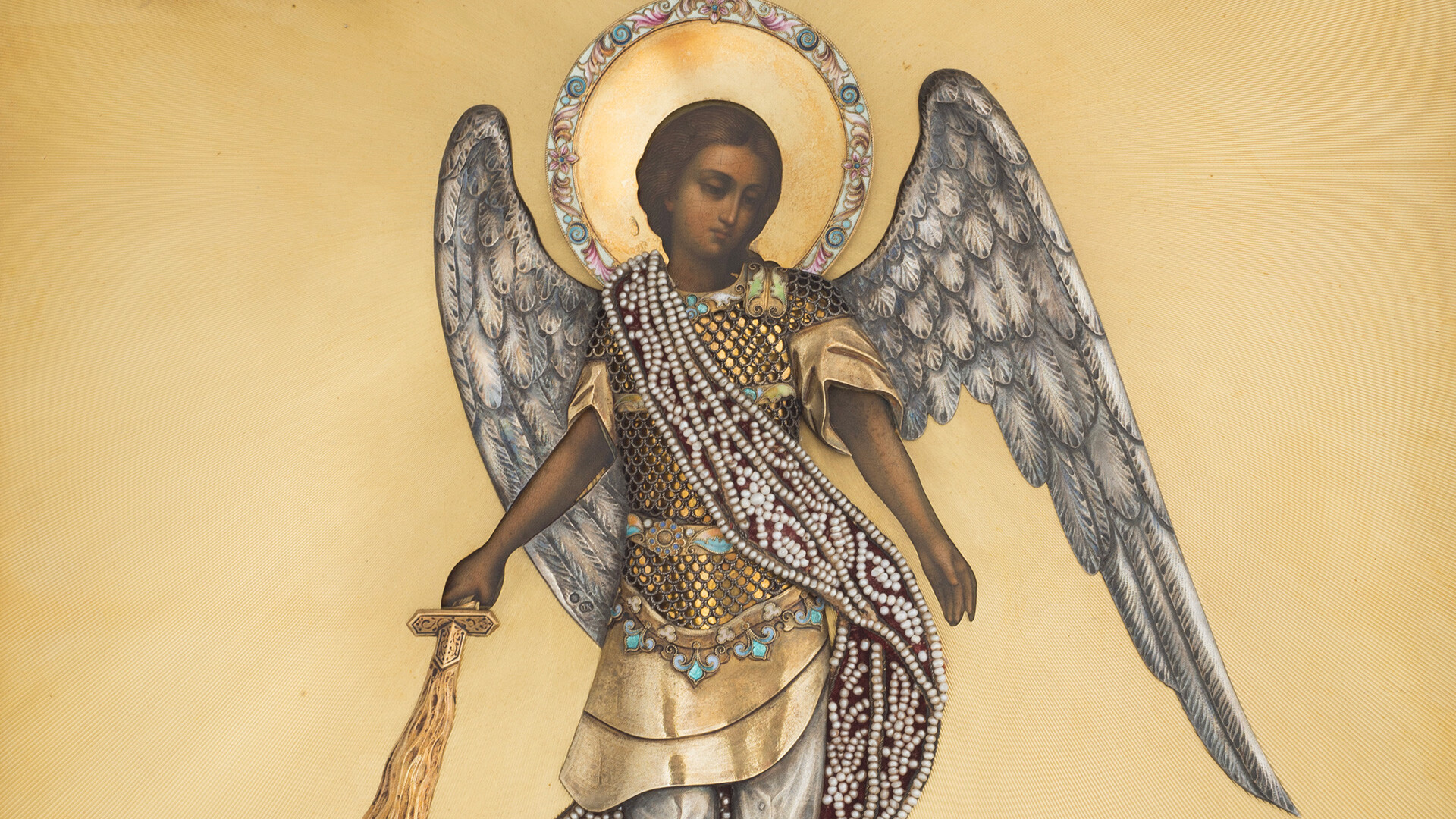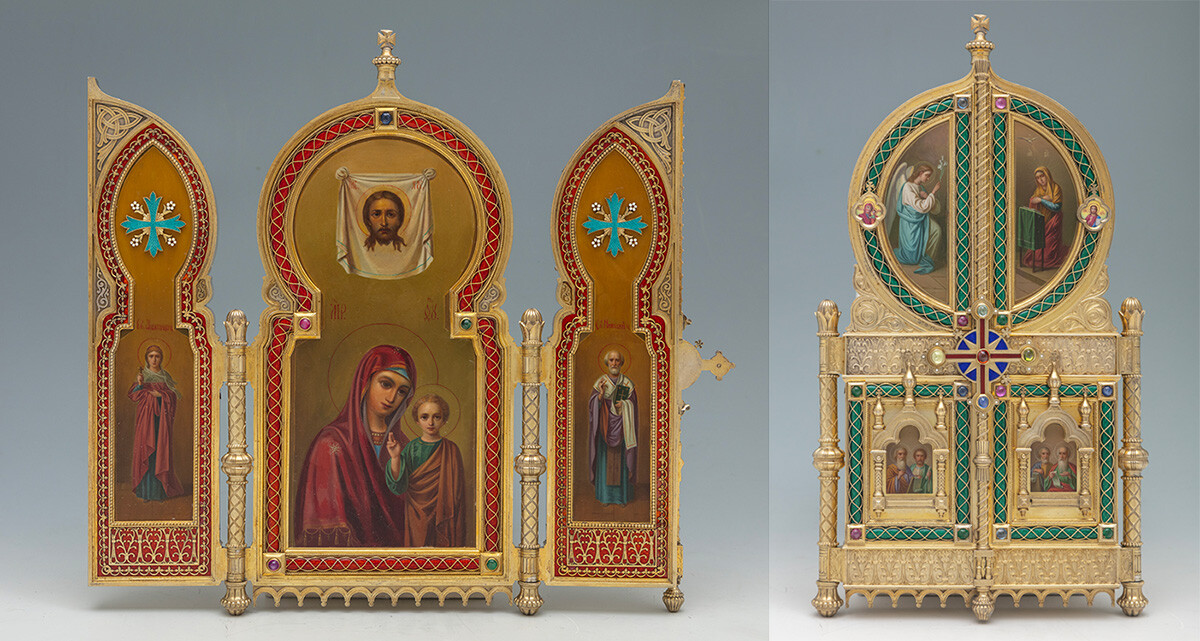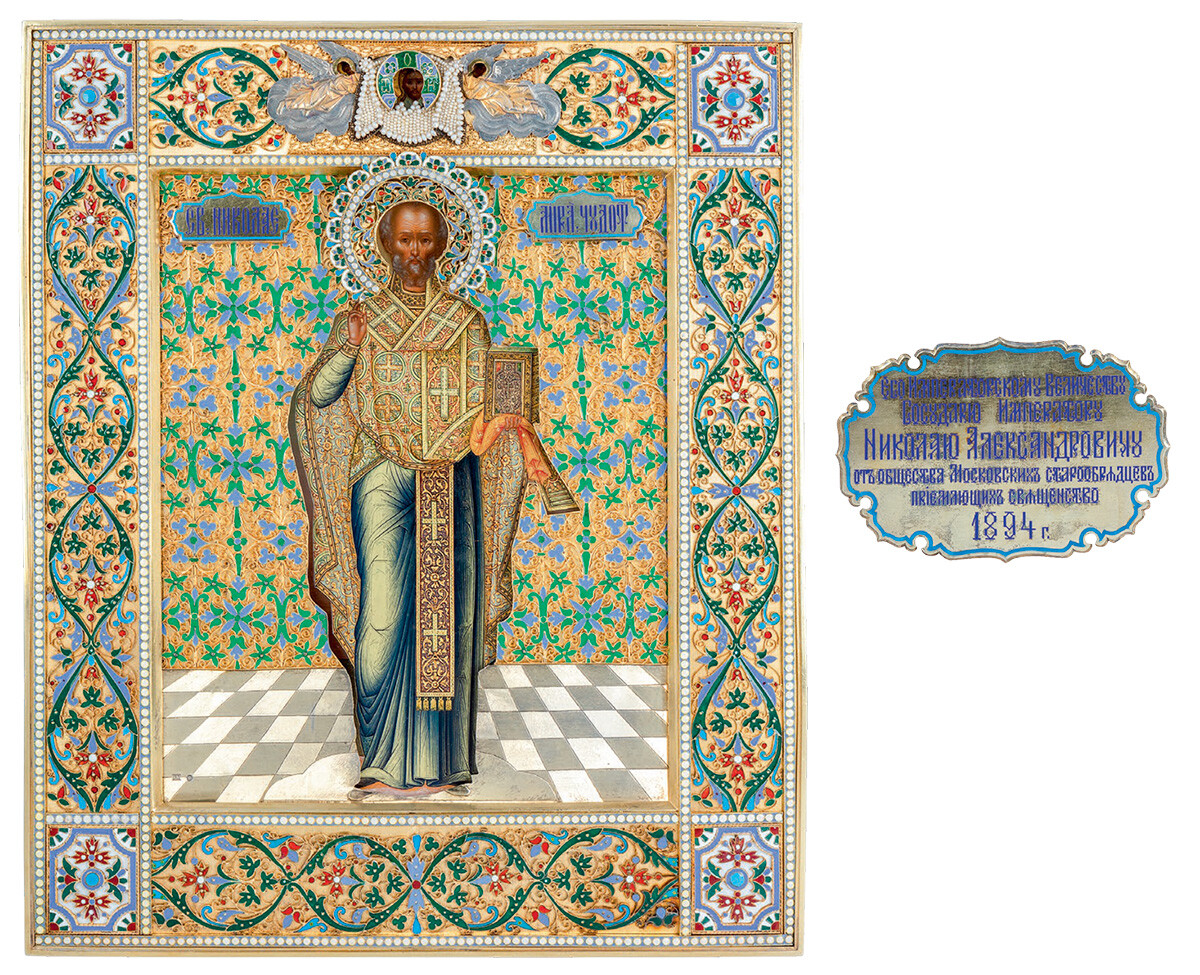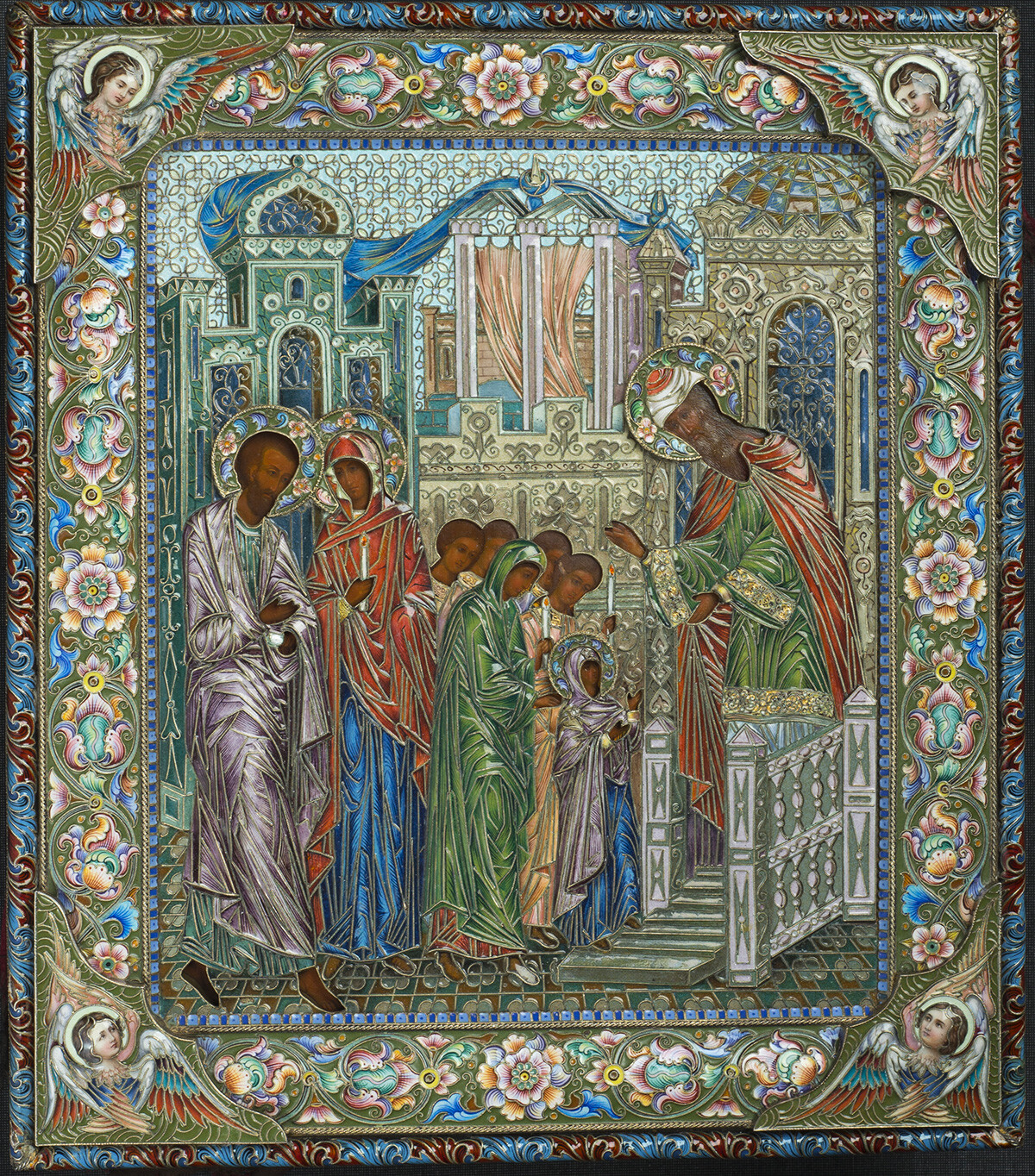10 precious icon rizas by Faberge and other Russian jewelers (PHOTOS)

Before the Bolshevik Revolution, images of Jesus Christ, the Virgin Mary and St. Nicholas the Miracle Worker could be found in almost every Russian home. Members of the nobility had special cases, or even entire shelves, where they kept icons in exquisitely crafted riza-frames. Icons were placed on wedding crowns and even inside Easter eggs.
The ornate decoration of religious icons is a tradition that dates to Byzantine times, and it expressed the highest degree of veneration of these sacred images. In Russia, the first decorated icons appeared in the 16th century, and by the late 19th century this art form had reached its highest level of expression.
Gold, silver, precious stones and enamel, as well as the most sophisticated chasing techniques, were used in the production of icon rizas. The finest court jewelers competed with each other and closely followed the current fashion and trends in art, including Art Nouveau and the so-called "Russian style".
1. “Christ Pantocrator” icon (1877)

Enamel was one of the most common techniques in the manufacture of frames. Icons brightly decorated with multicolored enamel looked elegant and elicited special admiration among those customers who were looking for an impressive gift.
The icon of Christ Pantocrator was made in the workshop of the Shelaputins, who were Moscow merchants and devout Old Believers. They supplied icons and church utensils not only to the noble families of the Old Believers, such as the Morozovs and Ryabushinskys, but also to the Intercession Cathedral in Rogozhsky Cemetery, the main church of the Old Believers.
Here, the technique of cloisonné enamel with vegetal ornament is used. The master used a limited number of colors – mainly gold, blue and white. The latter harmonizes with the Savior's Robe decorated with pearls.
2. “Our Lady of Kazan” icon (1890)

Pavel Ovchinnikov was the owner of a gold and silverware factory in Moscow and he was a real trendsetter for icon frames, which were in great demand at the imperial court. During an exhibition in Moscow, Ovchinnikov's selection of items earned the attention of Emperor Alexander II, who granted the jeweler the status of supplier to the imperial court.
The icon rizas made by Ovchinnikov's company are often distinguished by floral ornament and colored enamel. Over time, the firm began to frequently draw inspiration from the so-called "Russian style", but the frames also show the influence of Art Nouveau style. (Read more about Pavel Ovchinnikov here.)
3. The icon of “the Savior Not Made by Hands” (1894)

The demand for Ovchinnikov's work was enormous, and his team of skilled craftsmen could not always cope with the large number of orders. So, sometimes he asked for help from other factories, and in such a manner he commissioned Antip Kuzmichev to make several covers and icons, including this folding icon. It shows masterful work with enamel, and highly artistic chasing and engraving on metal. By the way, Kuzmichev's work was appreciated in the West, and the famous American firm Tiffany collaborated with him.
4. The folding triptych icon of “Our Lady of Kazan, with the image of the Savior; St. Nicholas the Miracle Worker, and Martyr Queen Alexandra” (1894)

Carl Fabergé was famous for his precious Easter eggs, which he made for the imperial family and other wealthy patrons over the course of almost three decades. But Fabergé also made many different items for the Emperor and his family, ranging from cups and vases to ashtrays and precious icons.
For example, this 30 cm high folding icon was made by Fabergé jewelers for the wedding of Nicholas II and his wife Alexandra Feordorovna. Inside the icon is the depiction of the Mother of God with a Child, and above her is the face of the Savior Not Made by Hands. The sides depict the patron saints of the emperor and empress, Nicholas the Miracle Worker and Tsarina Alexandra. The Annunciation and the Evangelists are seen on the outer casements.
5. Icon of “St. Nicholas the Miracle Worker” (1894)

In the year of Nicholas II’s coronation, the Moscow Old Believers presented the newly crowned tsar with an image of his namesake, St. Nicholas the Miracle Worker, who is one of the most revered saints in Russia.
Upon looking at this icon one can see the influence of an ancient relic - the special measuring icon for Ivan the Terrible’s newborn son, Tsarevich Ivan, which dates to the middle of the 16th century (check out the icon here). The appeal to the medieval era and the "Russian style" was a common feature for the Old Believers.
6. Icon of “St. Nicholas the Miracle Worker” (1899-1908)

The Moscow factory of the Galkin Brothers was famous for its chasing and engraving. Most often they sold icons and church utensils for home use and also made frames for private orders.
On the sides of the icon with St. Nicholas the Miracle Worker one can clearly see the chasing in the form of a curly vine stem. The superimposed corners are made of enamel. The center of the composition and the main decorative element is a wreath that goes around the saint’s face. The background in fine ripples is made with the guilloché technique, which is mechanically engraved into an underlying material via engine turning. In the late 19th century such a technique was fashionable and was valued even more than hand-chasing.
7. Icon of the “Entry of the Most Holy Theotokos into the Temple” (1899-1908)

Feodor (Friedrich) Rückert was a goldsmith of German origin. He ran a small jewelry workshop where he mainly produced objects of decorative art in which he primarily used Russian folk motifs. Rückert also decorated small icons and collaborated with large firms like Fabergé, sometimes fulfilling orders for them.
The icon’s frame is completely covered with enamel (which was a rarity) and even the painting is almost entirely executed in the enamel technique. Tiny metal lines outline not only the contours of the figures but also the folds of the saints' garments. Even the landscape and the smallest details of the background are performed in this technique.
8. Icon of the “Holy Trinity, with St. Antipius and Venerable Macarius in the margins” (1899-1908)

In 1904, the silversmith Dmitry Smirnov won a medal at the All-Russian exhibition of church utensils. Originally from the ancient city of Suzdal, he moved to Moscow and, thanks to his determination and talent, set up his own factory. Amid an environment of intense competition he created magnificent icon rizas in the Art Nouveau style and became famous among wealthy patrons. This particular icon has wide margins with vegetal curls on the edges and an embossed middle part where the artist placed many precious stones.
9. Folding icon of “Our Lady of Pochaev, Venerable Job of Pochaev, Prince Feodor Ostrogski” (1899)

This half-meter-high folding icon was presented to Metropolitan Ioannikiy on the occasion of the 50th anniversary of his ecclesiastical service. The images of the Mother of God and the saints are made with the use of enamel, chasing and engraving. Of course, the wooden frame in the “Russian style” immediately attracts one’s attention. The unusual folding icon was made by the factory of Dmitry Smirnov, but it also bears the assay mark of Igor Farabrov's factory.
10. Icon “Archangel Michael” (1908-1917)

Orest Kurlyukov, a purveyor to the imperial court, organized his own factory and became a leader in silversmithing. He was known for making very sophisticated icon frames, with many elements and techniques, but he also made simple and laconic rizas, such as this one. In the "Archangel Michael" icon there is no clutter of decorative elements, and the frame is designed in a highly sophisticated manner. Feathers are embossed on the Archangel's wings and meshed chainmail covers the gilded tunic. The cloak is decorated with pearls on a red foil backdrop.
The exhibition of Russian icons in precious frames from the collection of the Karisalov family and the Fabergé Museum is held at the Fabergé Museum in St. Petersburg until the end of 2023.


